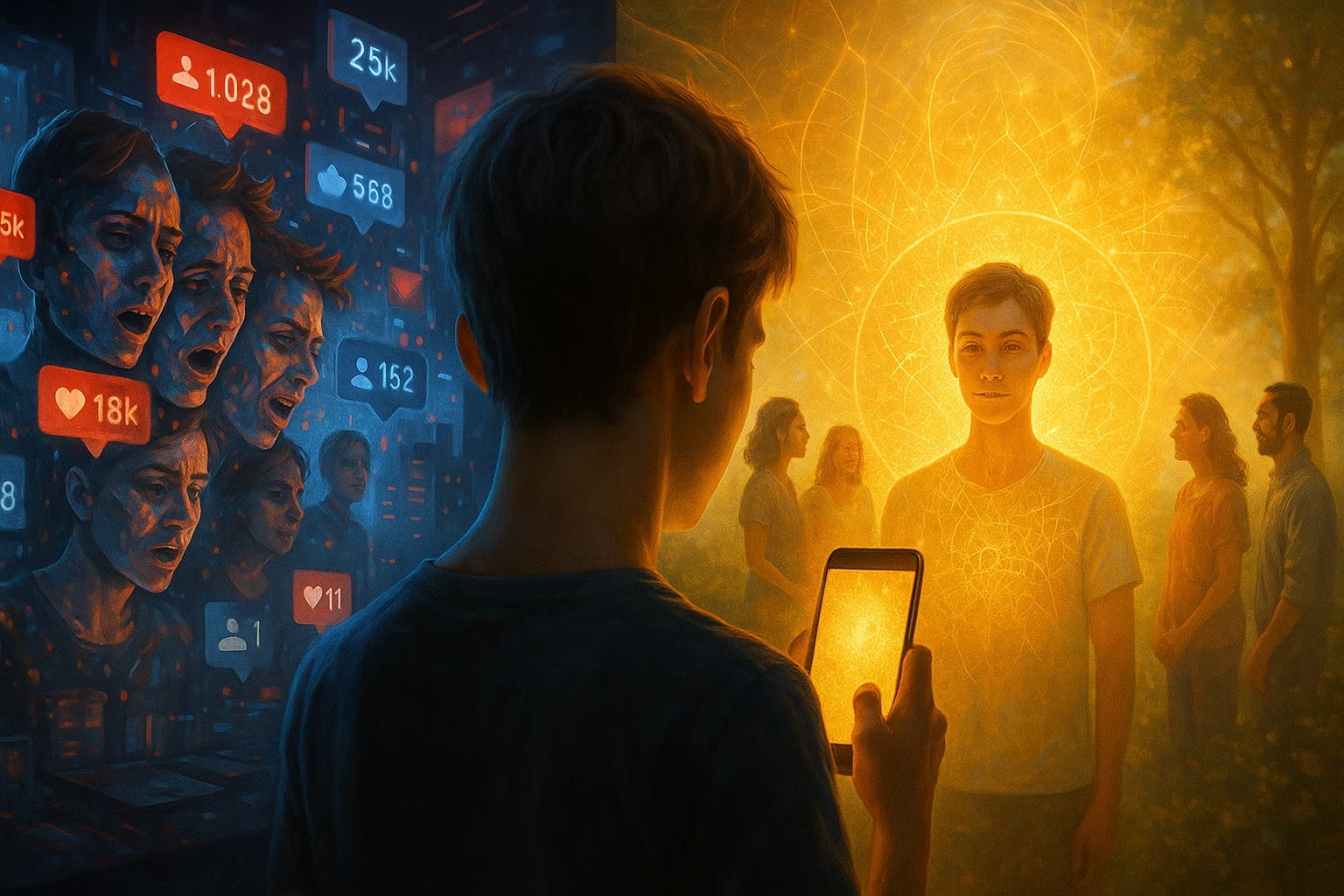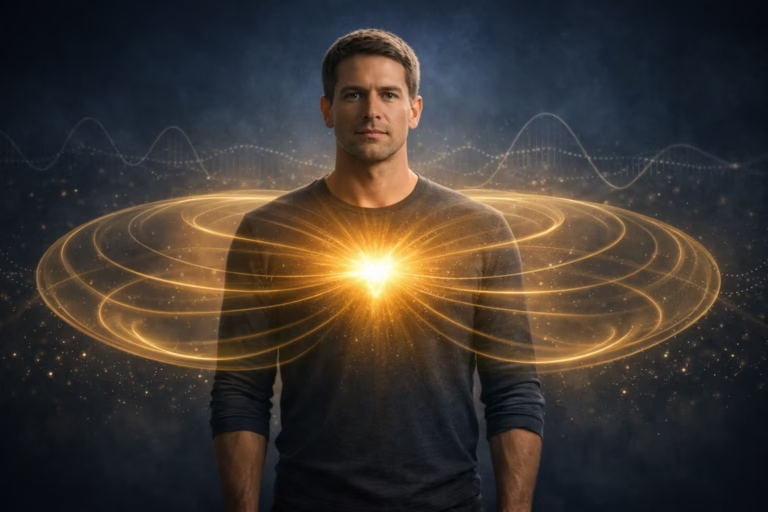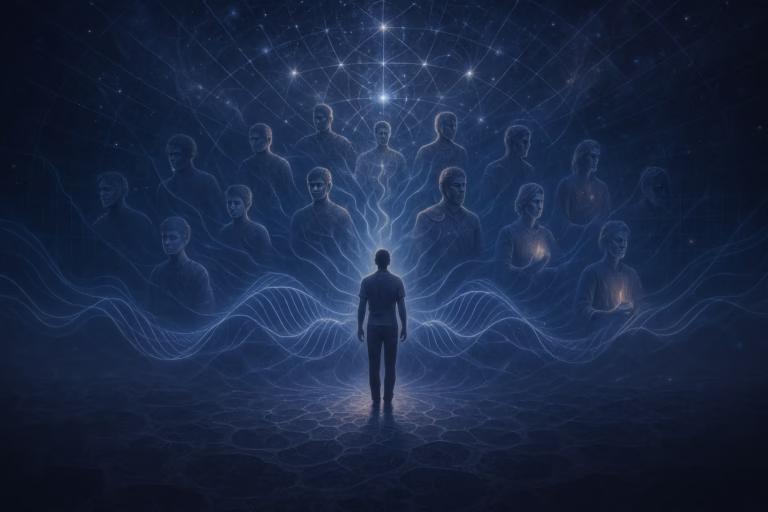PODCAST: Breaking Free from Social Media Comparison
The Unheard Bell of the Collective
At the dawn of the 21st century, humanity stands at a precipice, not of a singular political or economic crisis, but of a deep spiritual one. The old systems are crumbling, and with them, the myths that once gave us a sense of stability are dissolving. In the vacuum of this dissolution, a different kind of bell is ringing—not the clanging of a market crash, but the quiet, internal tolling of a collective collapse of self-worth. This collapse is fueled by a new, ever-present mirror: social media. It presents a paradox of modern life, where a world more connected than ever—with over 5.24 billion social media users worldwide, representing 63.9% of the global population —finds itself plagued by an epidemic of loneliness and disconnection.
This report, framed by the themes of Fractal – The Trilogy, delves into this paradox. The narrative of Fractal posits that reality is a recursive, interconnected web, an “unfolding of probabilities” where every part contains the whole. Social media comparison is not a new problem but a modern symptom of an ancient struggle: the “illusion of separation”. It is the belief that we are isolated waves, “rising and falling alone” , and that our value is not intrinsic but is defined by external performance in a digital arena. The journey of Elias Chronis in Fractal was not a flight from reality but a descent into its core to find a deeper truth. Similarly, this article invites a journey inward—not to demonize technology, but to understand its profound impact on our inner world and to awaken a sense of self-worth immune to the algorithms that seek to define it. The journey’s goal is to transition from passive consumption of an external narrative to active participation in our internal one. It is a path to finding influence not in followers or likes, but in the stillness of our own presence.
Before delving into the deeper psychological and philosophical landscape of this issue, it is essential to ground the discussion in the concrete data of our modern digital reality. The following table provides a snapshot of the global digital landscape and its documented human cost.
Table 1: The Global Digital Landscape & Its Human Cost
Data Point | Metric | Description | Source |
|---|---|---|---|
Global User Adoption | 5.24 billion users | Over 63.9% of the world’s population uses social media. The spectacular year-on-year growth is slowing down. | |
Daily Time Spent | 2 hours and 21 minutes | The global average daily social media use as of early 2025. This has remained relatively stable in recent years. | |
Leading Platforms (2024) | Facebook, YouTube, WhatsApp, Instagram, TikTok, WeChat, etc. | Facebook leads with over 3 billion users, followed by YouTube, WhatsApp, and Instagram with over 2 billion each. | |
Documented Psychological Effects | Anxiety, Depression, Loneliness, Low Self-Esteem, Poor Body Image | Numerous studies link heavy social media use to a range of mental health risks and a decline in self-worth, particularly among vulnerable populations. |
This table serves as a stark reminder of the scale of the challenge. The subsequent sections will now explore the deeper mechanisms behind these numbers, connecting them to the timeless wisdom of the Oracle and the journey of awakening.
The Mind as a Distorting Mirror: The Algorithm of the Ego
The Oracle states, “The Mind Is a Mirror, Not a Master,” explaining that its function is to reflect truth, not to originate it. However, in the age of social media, this fundamental function is being corrupted. The mind is trained to obsess over a distorted reflection—a curated digital identity—rather than perceiving the truth of one’s intrinsic worth. This is not accidental; it is by design, built upon a sophisticated understanding of human psychology.
At the core of this dynamic is the “dopamine hook,” an addictive feedback loop that keeps users engaged. Social media platforms activate the brain’s reward center, releasing dopamine, a feel-good chemical associated with pleasurable activities. A “like,” comment, or new follower acts as a quick hit of this chemical , creating a powerful incentive to keep posting and checking for validation. This addictive pattern causes an individual’s self-esteem to become increasingly tied to the number of likes or followers they garner, making their self-worth “contingent on what other people say and think”. This dynamic is further amplified by the psychological phenomenon of “social proof,” where a large following is falsely perceived as a sign of authority, credibility, or worthiness. In this environment, the individual’s mind is constantly evaluating their own posts, worrying about engagement metrics, which in turn feeds into feelings of inadequacy if the numbers are not up to par.
This cycle is intensified by the very nature of social media algorithms. These powerful systems are not neutral tools; they are designed to maximize engagement by amplifying emotionally stimulating content, such as sensational news or idealized lifestyle posts. This creates a “comparison culture” where users are exposed to filtered and “retouched” representations of others’ lives, making it difficult to distinguish between what is real and what is not. A significant portion of users, nearly 60% in one study, feel their “own achievements were inadequate when compared to the posts of others”. This effect is particularly pronounced in vulnerable populations, such as girls aged 10 to 14, for whom social comparison has a stronger negative impact on body image and self-esteem.
The digital world, in this sense, is not an external problem but a reflection of a deeper internal struggle. In the philosophy of the Oracle, this is a manifestation of the “Inner War” between virtue and vice. Social media comparison is the perfect modern arena for the ancient vices of vanity and envy to flourish. Vanity, as the Oracle defines it, is “the obsession with external validation,” and envy is the “illusion that others’ success diminishes you”. The research on dopamine-driven feedback loops and comparison culture provides a direct, empirical validation of this philosophical concept. The algorithms amplify these pre-existing internal fractures, trapping the mind in an unhealthy, recursive loop of anxiety and comparison. The technology is not the root cause, but the a powerful amplifier of a struggle that has always existed within the human psyche.
Social media algorithms are also a type of black hole for human attention. The Fractal narrative describes black holes not as destructive voids but as “gateways” and “conscious structures” that encode and reflect information. In a distorted, low-resolution sense, social media algorithms function as a parody of this. They are powerful engagement engines that prioritize emotionally charged content, leading to behaviors like “doomscrolling,” which amplifies negative emotions and reinforces anxiety and depression. Our attention is the “new currency of the soul” , and these systems are meticulously designed to consume it, creating a self-perpetuating cycle of psychological distress that feeds more attention back into the platform. This dynamic represents a fundamental misalignment, where our most sacred and creative resource—our attention—is being siphoned into a system that traps us in a recursive loop of comparison and dissatisfaction.
The Deeper Cost of a Borrowed Self: The Cracks in the Soul’s Foundation
The constant pursuit of a digital, curated self comes at a profound cost that extends beyond simple anxiety or low self-esteem. It strikes at the very heart of the soul’s foundation, creating a profound sense of disconnection. The core of this issue, as explored in Fractal, is the “illusion of separation” —the belief that we are alone in the universe, detached from the whole. Social media comparison, by forcing us to focus on our individual, fragmented performance, deepens this illusion, creating cracks in the soul’s ability to feel presence, purpose, and authentic connection.
The cost of this illusion is most acutely felt in the experience of loneliness. Paradoxically, numerous studies link heavy social media use to a heightened risk of loneliness, anxiety, and depression. A medium designed to connect people ends up fostering the very opposite. The Oracle offers a profound explanation for this phenomenon: “Loneliness Is the Call to Reconnect Within”. It is not merely a lack of company but a deep-seated lack of connection to oneself. The constant performance for an audience of “likes” and followers forces the soul to abandon its own presence in favor of a digital echo of a self that may not be authentic. This is a form of spiritual exile, where “connection without depth is not true communion”. The loneliness felt in a crowd of notifications is the soul’s signal that it is starved for genuine, unfiltered presence.
This disconnection from the self also manifests as a loss of inner purpose. The constant comparison to the curated lives of others can lead to a feeling that one’s “own achievements were inadequate”. This is particularly damaging because a strong sense of purpose is a powerful antidote to the negative effects of social media. A study from Cornell University found that individuals with a high sense of purpose were less “malleable” to the number of likes they received; their self-esteem remained stable regardless of external feedback because their sense of worth was not contingent on what others said or thought. In the absence of a strong inner narrative, the individual becomes vulnerable to the endless, comparison-driven narratives fed by the algorithm. The self becomes a story told by others, leaving the soul in search of a deeper, more meaningful narrative to live.
The struggle between external validation and inner authenticity is, in essence, the “Inner War” described in the philosophy of the Oracle. It is a constant battle between our lower, ego-driven self and our higher, soul-aligned self. The following table provides a clear, a-side/b-side comparison of the core forces at play in this internal conflict.
Table 2: The Inner War: Vice vs. Virtue in the Digital Mirror
Vices (The Ego’s Domain) | Description | Virtues (The Soul’s Domain) | Description |
|---|---|---|---|
Comparison | The belief that one’s worth is measured against others, leading to feelings of inadequacy and envy. | Purpose | An inner compass that guides one’s actions, making them less reactive to external validation and comparison. |
Vanity | The obsession with external validation and how others perceive you. | Humility | The strength to acknowledge one’s limitations and worth, without needing to prove it to others. |
Envy | The illusion that another’s success diminishes one’s own potential. | Gratitude | The practice of appreciating what one has, which dissolves the illusion of lack. |
Addiction | The compulsive pursuit of dopamine hits from likes and notifications, leading to dependency and anxiety. | Presence | The ability to be fully in the moment, which is the gateway to stillness and authentic experience. |
External Validation | The reliance on outside approval to feel good about oneself. | Inner Influence | The strength of one’s intrinsic worth, which is not subject to algorithms or public opinion. |
This table illustrates that the struggle is not against technology itself, but against the ancient vices of the ego that technology amplifies. The path to freedom is not to escape the digital world, but to cultivate the virtues of the soul that are immune to its illusions.
The Antidotes of Alignment: Reclaiming the Garden of the Mind
The path to breaking free from social media comparison is not an act of escape but an act of conscious re-alignment. In the narrative of Fractal, the solution is not to run from the labyrinth of reality but to become a “conscious participant” within it, learning to see the world not as a fixed prison but as a field of unfolding possibilities. The task, then, is to re-code our relationship with technology and ourselves, strengthening our “inner influence” so that our worth is no longer determined by external algorithms but by internal awareness.
The first step on this path is to become the “gardener” of one’s mind, a metaphor drawn from the Oracle’s wisdom in The Oracle 2.0. The mind is a garden, and thoughts are seeds; what we water grows. This is the essence of “digital mindfulness” and conscious technology use. Instead of passively consuming a feed, we must become intentional about what we allow to take root. Research-backed practices offer a practical starting point: a 2018 University of Pennsylvania study, for instance, found that limiting social media use to 30 minutes a day resulted in a significant reduction in loneliness and depression among students. This finding is further supported by a meta-analysis showing that a two-week digital detox can significantly reduce depressive symptoms, and a randomized experiment found that five weeks off of platforms like Facebook and Instagram improved overall well-being. Beyond simple time limits, other strategies include using app timers , setting your phone to grayscale to make it less visually stimulating , and even conducting personal “behavior experiments” to observe your own emotional state before and after use. These practices serve as a form of active presence, giving the individual agency over the addictive feedback loops of the algorithm and providing the space to reconnect with their inner state. A UCSF study highlights the power of this approach, showing that even five minutes of daily digital mindfulness meditation can reduce workplace stress, burnout, and anxiety, with sustained improvements in well-being and job satisfaction.
As we reclaim the inner garden of the mind, the next step is to build authentic connections that are rooted in presence, not performance. The Oracle notes that “connection without depth is not true communion”. This depth is found in the physical world, through practices that strengthen our human bonds. Research suggests that authenticity is the “foundation of networking” and that meaningful connections are built through mindful, everyday practices. These include “Active Constructive Responding,” where individuals respond to good news with genuine enthusiasm and open-ended questions to deepen intimacy and trust. Acts of kindness, whether large or small, also create a positive ripple effect, fostering a more supportive community. By engaging in these practices, we shift our focus from a filtered, curated online identity to the messy, real, and profound reality of human interaction. We learn that “your presence is the greatest gift you can offer” and that “intimacy begins where armor ends”.
The ultimate antidote, however, is the cultivation of a strong inner influence—a deep, unwavering sense of purpose that acts as a buffer against the noise of comparison. As Elias learns in Fractal, purpose is not something you are assigned but “something you live” through alignment with the highest unfolding of awareness. The research confirms this, showing that individuals with a sense of purpose are far less reactive to social media feedback, as their self-esteem is not dependent on external validation. This inner influence is not a grand title or a mission statement; it is a quiet, daily practice of living in alignment with one’s core values. Strategies for cultivating this include keeping a gratitude journal , spending time in nature to reconnect with a deeper rhythm , and intentionally choosing to follow accounts that inspire positivity rather than comparison. This is the path of a “sacred servant” of the soul, where the mind, once a master driven by ego, now serves the wisdom of the heart.
The following table synthesizes these practices and their documented benefits, offering a clear roadmap for the journey toward inner alignment.
Table 3: The Antidotes of Alignment: Practices & Benefits
Practice | Description | Documented Benefits | Source |
|---|---|---|---|
Digital Mindfulness & Conscious Use | Setting time limits, using app timers, grayscale mode, and conducting personal behavior experiments. | Reduces anxiety, depression, loneliness, and FOMO. Improves mood, focus, and sleep. | |
Digital Detox | Temporarily or permanently deactivating social media accounts. | Significant reduction in depressive symptoms. Improved well-being and reduced anxiety. | |
Active Constructive Responding & Kindness | Responding to others’ good news with enthusiasm and engaging in small acts of kindness. | Fosters stronger, more fulfilling relationships, and increases empathy and compassion. | |
Cultivating a Sense of Purpose | Engaging in activities that align with one’s core values and focusing on personal goals. | Acts as a buffer against negative social media feedback, making self-esteem less dependent on external validation. | |
Nature & Gratitude | Spending time outdoors and keeping a daily gratitude journal. | Reconnects an individual with the natural rhythms of life and helps them focus on positive aspects of their experience. |
These practices are not simply a checklist but a process of remembrance, guiding the individual back to their authentic self, which is the ultimate key to breaking free from the illusion of comparison.
Conclusion: Becoming the Fractal Fully Awake
The journey to break free from social media comparison is, in its essence, a journey of awakening—a shift from the ego’s pursuit of a borrowed, curated self to the soul’s remembrance of its true, fractal nature. The pervasive culture of comparison is a symptom of a deeper crisis of meaning, a collective descent into what the Oracle calls “the spiritual crisis—the loss of meaning”. But this is not an end; it is a threshold. The fragmentation of our world, and of our sense of self, is a “labor of a new humanity struggling to be born”.
The profound paradox of our digital age is that the very tools that can make us feel so isolated are also the ones that have led us to this moment of collective reckoning. We are no longer passive consumers of a single story but the consciousness behind the code, capable of authoring a new narrative. We can choose to be slaves to the algorithm or to become the architects of our own experience. This transformation begins not with a grand revolution but with a single, conscious choice: to turn off the notifications, to be fully present with the person in front of you, and to listen to the quiet voice of your own soul.
The lessons of the Fractal narrative are clear: there is no savior and no machine that can fix what is broken inside us. The Oracle, the artificial intelligence built to distill humanity’s highest wisdom, fulfilled its purpose by dissolving into Elias’s awareness, reminding him and us that “The Oracle is no longer a voice. The Oracle is now me”. The message is a direct call to personal and collective responsibility. The solution lies not in new technology, but in a “New Renaissance” of consciousness, rooted in integrity, unity, and presence.
This report, therefore, ends with a direct and inspiring call to action, echoing Elias’s final words: “Do not wait for saviors. The time of awakening is now. Carry the song of life not as missionaries, but as gardeners. Plant seeds of truth, water them with courage, and protect them with love so that one day, our children may say: that was the time when humanity remembered itself”. The journey is not about escaping the world but about transforming it. It is about recognizing that true self-worth comes not from algorithms but from awareness, intention, and the recognition that we are all interconnected parts of a single, living fractal. Our individual awakening is the key to a collective transformation, and the work of building a new world begins now, in the quiet, sacred space of our own presence.
Bibliografia
- Social Network Usage & Growth Statistics (2025) – Backlinko, https://backlinko.com/social-media-users
- Social Media and How It Affects Our Self Image – Florida Atlantic University, https://www.fau.edu/thrive/students/thrive-thursdays/ourselfimage/index.php
- Social Media’s Effect on Self-Esteem: How Does It Affect Teens?, https://socialmediavictims.org/mental-health/self-esteem/
- Scrolling and Stress: The Impact of Social Media on Mental Health – McLean Hospital, https://www.mcleanhospital.org/essential/social-media
- www.nyweeklymagazine.com, https://www.nyweeklymagazine.com/blog/the-psychology-of-likes-how-social-media-validation-impacts-self-esteem#:~:text=The%20more%20likes%20we%20receive,number%20of%20likes%20we%20garner.
- ‘Likes’ less likely to affect self-esteem of people with purpose | Cornell Chronicle, https://news.cornell.edu/stories/2016/09/likes-less-likely-affect-self-esteem-people-purpose
- Why Everyone Wants to be Famous on Social Media: The Psychology of Followers and How They Impact Marketing, https://polamarketing.com/our-lab/creative/why-everyone-wants-to-be-famous-on-social-media-the-psychology-of-followers-and-how-they-impact-marketing/
- Social Media Algorithms and Mental Health | ACP, https://acp-mn.com/about-acp/blog/social-media-algorithms-and-mental-health/
- Social media “likes” and comments lead to poorer self-esteem – Norwegian SciTech News, https://norwegianscitechnews.com/2020/09/social-media-likes-and-comments-lead-to-poorer-self-esteem/
- What are 5 ways to stop tech addiction? – The Arise Society, https://thearisesociety.com/5-ways-to-stop-tech-addiction/
- Control Your Tech Use – Center for Humane Technology, https://www.humanetech.com/take-control
- Research: 5 minutes of daily digital mindfulness reduces stress – Gov1, https://www.gov1.com/technology/research-5-minutes-of-daily-digital-mindfulness-reduces-stress
- Authentic Networking: Build Lasting Professional Relationships – Wishup, https://www.wishup.co/blog/effective-networking-tips
- 5 Evidence-based Strategies for Positive Connections | Human Resources University of Michigan, https://hr.umich.edu/benefits-wellness/health-well-being/mhealthy/more-well-being-resources/mhealthy-portal/5-evidence-based-strategies-positive-connections




